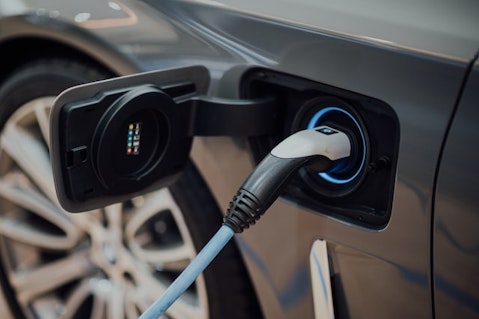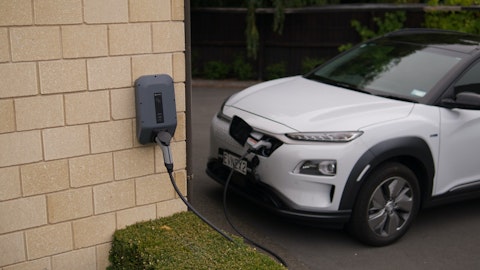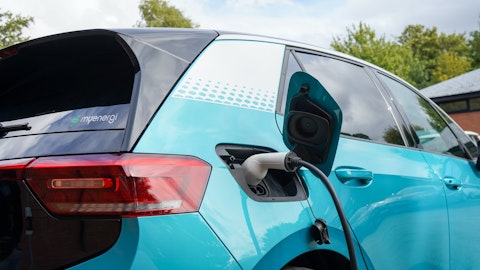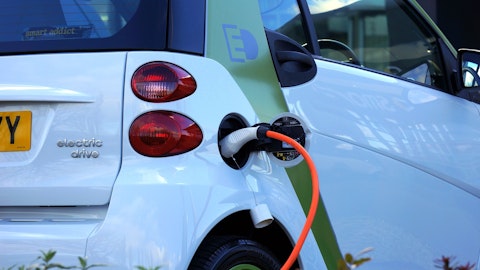ChargePoint Holdings, Inc. (NYSE:CHPT) Q4 2023 Earnings Call Transcript March 2, 2023
Operator: Ladies and gentlemen, good afternoon. My name is Lisa, and I’ll be your conference operator for today’s call. At this time, I would like to welcome everyone to the ChargePoint Fourth Quarter Fiscal 2023 Earnings Conference Call and Webcast. I would now like to turn the call over to Patrick Hamer, ChargePoint’s Vice President of Capital Markets and Investor Relations. Patrick, please go ahead.
Patrick Hamer: Good afternoon, and thank you for joining us on today’s conference call to discuss ChargePoint’s fourth quarter and full fiscal 2023 earnings results. This call is being webcast and can be accessed on the Investors section of our website at investors.chargepoint.com. With me on today’s call are Pasquale Romano, our Chief Executive Officer; and Rex Jackson, our Chief Financial Officer. This afternoon, we issued our press release announcing results for the quarter and full year ended January 31, 2023, which can also be found on our website. We’d like to remind you that during the conference call, management will be making forward-looking statements, including our outlook for the first quarter fiscal 2024. These forward-looking statements involve risks and uncertainties and many of which are beyond our control and could cause actual results to differ materially from our expectations.
These forward-looking statements apply as of today, and we undertake no obligation to update these statements after the call. For a more detailed description of certain factors that could cause actual results to differ, please refer to our Form 10-Q filed with the SEC on December 8, 2022 and our earnings release posted today on our website and filed with the SEC on Form 8-K. Also, please note that we use certain non-GAAP financial measures on this call, which we reconcile to GAAP in our earnings release for certain historical periods in the investor presentation posted on the Investors section of our website. And finally, we’ll be posting the transcript of this call to our Investor Relations website under the Quarterly Results section. And with that, I’ll turn the call over to Pasquale.
Pasquale Romano: Thank you, Patrick, and thanks to everyone for joining us today. Yesterday marked our second anniversary of being a public company, and I’d like to start by recognizing the team here at ChargePoint that has worked tirelessly to continue to evolve the company to fulfill the enormous role we play in the energy transition. Before I get into a bit of retrospective on the full year and what the road ahead holds for us, I’ll review the fourth quarter results for fiscal 2023. Our fourth quarter grew 93% year-on-year and 22% sequentially, making another record quarterly revenue level for the company, while improving non-GAAP margins by 3 points to 23%, delivering on our expectations set on our last call that we would sequentially improve gross margin.
However, on that same call, we effectively raised the midpoint of our full year guidance by $5 million. The revenue results for the full year were slightly below the original guidance midpoint and 2.5% below the revised guidance midpoint. Fourth quarter revenue results were below the guidance range and 7% short of the midpoint. This was due to a combination of special circumstances. The first is a decrease in North American commercial demand during the month of December; the second, while overall supply chain limitations have eased, they persist for certain hardware products; and lastly, we just missed shipment cutoffs for some customers that caused a larger gap between billings and revenue than historical norms. To put that in perspective, the full year revenue was $468 million.
Our business grew 94% this year versus last and over 90% year-on-year each quarter. We managed operating expenses through the year to achieve the improving operating leverage you see. And this is foundational to becoming cash flow positive in calendar 2024. We are exceptionally proud of crossing through an annualized subscription revenue benchmark of $100 million. We also demonstrated growth in fleet as a major vertical globally in our European business across all verticals. Both of these outpaced the 94% growth rate of the company to gain ground as a percentage of overall revenue. A good example of our progress in fleet and the power of our ecosystem is the recent announcement of the United States Postal Service Award with our distribution partner, Rexel.
Partnerships like these are critical pieces of our differentiated business model. In the fourth quarter, over 70% of billings were through our channel partners, consistent with historical results. And even with limitations on vehicle supply, in the vertical, fleet is already a significant component of our revenue and a coiled spring when the vehicles are readily available. This is an essential part of our growth strategy. Participating in nearly every vertical of EV charging in both Europe and North America not only fuels our growth, but also provides resilience in the face of short-term emphasis shift across verticals and geographies. We benefited from this in COVID years and expect this diversity to be an asset as the market continues to develop for years to come.
Let me give you a sense of where we have been this past year to help you gauge how well we are positioned for the future. We operate at the center of an expanding ecosystem that’s highly invested in the electrification and mobility. We are now seeing that investment accelerate from those force multipliers. And this indicates that the ecosystem, not just the auto industry, is past the point of no return. Some examples, ChargePoint now has over a dozen automotive partnerships live where ChargePoint’s cloud service aggregates access to all major public charging networks in Europe and North America via the OEMs’ in-dash system or companion app. Partners added this year include Lexus, Mazda, Toyota and Fisker this year. Additionally, many auto OEMs offer our ChargePoint home charger and recommend us to their dealers for their charging needs.

Photo by CHUTTERSNAP on Unsplash
We added numerous fleet OEMs as partners as well. We continue to work with the iOS and Android platforms as well as the native Google car experience. We added UTA, a leading European fuel card provider to our long list of payment partners. We added Stem and other partners to enable charging to be integrated into broader site-wide energy management. We continue to grow our channel partner network and launched our mobile application for installers as our first step in creating an education and support platform for these key players. We continue to work with governments in North America and Europe to shape policy and programs such as NEVI to remove barriers and ensure a vibrant and consistent charging market. And lastly, we announced partnerships with Volvo and Starbucks as well as Mercedes-Benz and MN8 Energy to enable great brands serving the 30-minute retail economy with the EV charging to create a fantastic road trip experience for EV drivers.
Turning to network, general customer and environmental statistics. We finished the quarter with over 225,000 active ports under management, including over 18,900 DC ports, with just under 1/3 of our overall ports in Europe. We also provided our drivers access to over 465,000 roaming ports with over 445,000 of those ports in Europe, significantly strengthening our EU offerings for . We now call 80% of the 2021 Fortune 50 and 55% of the 2021 Fortune 500 customers and over 70% of billings from existing customers consistent with historical norms and our land-and-expand strategy. As of the end of the quarter, we estimate that our network has now fueled approximately 5.6 billion electric miles avoiding approximately 224 million cumulative gallons of gasoline and over 1 million metric tons of greenhouse gas emissions.
While we are facing many of the same headwinds as the rest of the space, the momentum of the ecosystem in which we operate and our differentiated business model, were not only driving the near-term results we’ve seen, but position us to capitalize on what is clearly an inevitable long-term growth cycle. I’m proud of the ChargePoint team and our partners who made this year possible. Together, we are uniquely positioned to pursue this remarkable market opportunity, and I’m confident we are on the right trajectory heading into this year. Rex, over to you.
Rex Jackson: Thanks, Pasquale. As a reminder, please see our earnings release where we reconcile our non-GAAP results to GAAP, our principal exclusions or stock-based compensation, amortization of intangible assets and certain costs related to restructuring and to acquisitions. Also, we continue to report revenue of along three lines: network charging systems, subscriptions and other. Network charging systems represents our connected hardware. Subscriptions include our cloud services, connecting that hardware. Our assure warranties and our ChargePoint is the service offerings where we bundle our solutions into recurring subscriptions. Other consists of energy credits, professional services and certain nonmaterial revenue items.
Moving to results. Fourth quarter revenue was strong at $153 million, up 93% year-on-year and 22% sequentially, but below our previously announced guidance range of $160 million to $170 million, as Pasquale noted. Again, the shortfall was principally due to supply issues with our DC product lines as availability was better, but still not sufficient to hit the significant ramp from the third quarter to the fourth quarter. A lack of linearity to force shipments too late in the quarter to meet our revenue cutoff criteria and softer North American commercial demand than expected also contributed. Network charging systems at $122 million was 80% of fourth quarter revenue, up 109% year-on-year and 25% sequentially. Subscription revenue at $26 million was 17% of total revenue, in line with its third quarter percentage contribution, up 50% year-on-year and 19% sequentially.
Importantly, as Pas mentioned, this quarter, we hit a significant milestone of $100 million in annual run rate for this revenue line. Further, our deferred revenue from subscriptions representing future recurring revenue from existing customer commitments and payments continued to grow nicely, finishing the quarter at $199 million, up from $175 million at the end of the third quarter. Other revenue was $5 million and 3% of total revenue, increased 37% year-on-year but was down 22% sequentially, largely due to decreased values of LCFS credits. Turning to verticals. We continue to report them from a billings perspective, which approximates the revenue split. Fourth quarter billings percentages were commercial 69%, fleet 19%, residential 11% and other at less than 1%, representing a several point gain for our fleet business versus last year.
From a geographic perspective, fourth quarter North America revenue was 86%, Europe was 14% as our European business continues to expand. In the fourth quarter, Europe delivered $22 million in revenue, growing 129% year-on-year and 26% sequentially. Turning to gross margin. Non-GAAP gross margin for the fourth quarter was 23%, up from the third quarter at 20%. We were particularly pleased with this progress as cost reductions, higher ASPs and incrementally lower supply chain headwinds more than offset certain product transition costs. Specifically, we saw a 4-point drag from supply chain impact during the quarter. Non-GAAP operating expenses for the fourth quarter were $81 million, a year-on-year increase of 5% and a sequential increase of 2%.
We continue to manage operating expenses carefully and with several key product releases achieved earlier in 2022, new product introduction costs were lower in the fourth quarter. Stock-based compensation in the fourth quarter was $26 million. Recall that our annual refresh cycle will be in our second fiscal quarter. Looking at cash and equivalents. We finished the quarter with $400 million, slightly higher than $398 million at the end of the third quarter as we used our ATM or at-the-market offering program to raise $50 million in December. At the end of the fourth quarter, we had approximately 348 million shares outstanding. Turning to the year. Annual revenue was $468 million, up 94% year-on-year. Network charging systems at $364 million or 78% of total revenue for the year and up 109% year-on-year.
Subscription revenue of $85 million was 18% of total revenue and up 59% year-on-year. Other represented the balance of 4%. Quickly covering verticals for the year, billings by vertical. For the full year, we’re commercial 69%, fleet 17%, residential 12% and other 1%, like the fourth quarter reflecting particular strength in fleet. From a geographic perspective, full year revenue from North America was 84% and Europe was 16% as Europe outpaces our overall growth rate. In fiscal 2023, our European business delivered $73 million in revenue, up 190% year-on-year. Turning to gross margin. Non-GAAP gross margin for the year was 20%, down from 24% the previous year, principally due to a higher mix of DC products and to an approximately 5 percentage point supply chain and logistics impact.
Non-GAAP operating expenses for the year were $324 million, a year-on-year increase of 35% and managed well below our original targets for the year. Again, we are focused on delivering improved operating leverage as non-GAAP operating expenses as a percentage of revenue went from 103% in the first quarter to 53% in the fourth quarter. To maintain our path to profitability, we responded to fiscal 2023 gross margin shortfalls by spending $35 million less in non-GAAP operating expenses relative to our original annual guidance and essentially kept quarterly non-GAAP OpEx flat each quarter of the year. Turning to guidance. As you all know, we guided for the full year last year on revenue, gross margin and operating expenses. We did this because we were a newly public company and analyst estimates varied from our expectations too greatly across these measures.
As we look at fiscal 2024, there’s far less dispersion and external estimates. Accordingly, we believe annual guidance is not necessary this year. For the first quarter of fiscal 2024, we expect revenue to be $122 million to $132 million, a year-over-year increase of 56% at the midpoint. As you may recall, we typically see a seasonal drop in revenue from the fourth quarter to the first quarter at reload budgets and construction slows in the winter. However, keep in mind that in addition to being seasonally down from the fourth quarter, our first quarter historically contributes a significantly lower percentage of our annual revenue than quarters two through four. On other measures, we expect continued sequential improvement in gross margin this year as supply chain challenges continue to ease, our cost-down efforts continue and we get the benefit of volume on newer products.
Regarding operating expenses, we expect leverage to be lower in the first quarter on lower revenue, but then to improve through the balance of the year and for the year. Advances in these metrics are key to our commitments to turning cash flow positive in the fourth quarter of 2024. Reaching this milestone next year with the North American EV passenger fleet estimated by Bloomberg in at under 5% and under 8% in Europe, should position the company well early in the industry’s growth cycle. Operator, let’s move to Q&A.
Operator: We’ll go first to Colin Rusch, Oppenheimer.
See also 12 Most Promising Micro Cap Stocks and 13 Most Undervalued Penny Stocks.
Q&A Session
Follow Chargepoint Holdings Inc. (NASDAQ:CHPT)
Follow Chargepoint Holdings Inc. (NASDAQ:CHPT)
Colin Rusch : I wanted to dig into the seasonality piece of this because we see this in a variety of industries. And what it looks like it’s happened in the first quarter of your fiscal year as you end up pens out about 18% to 20% of the annual revenue and you’re guiding to something a little bit north of 50% here. I guess what can you say about the backlog and your visibility into the balance of the year? And how you’re thinking about the seasonal trajectory of revenue throughout the balance of the fiscal year.
Rex Jackson : Colin, thanks for the question. So if you look at our Q1 outlook, as I said in the prepared remarks, it’s a — we’re a growth company, right? So you end up with a lower percentage in Q1 relative to the percentage just for Qs two through four. So you can extrapolate, I think, successfully from there. Looking at your models and our historical performance, I think that’s something that you guys can do. From a backlog perspective, we actually did a nice job in Q4 of burning off some of the historical backlog. As we’ve said in prior quarters, we don’t actually think that backlog is necessarily a virtue. We’re not a backlog business, particularly maybe that changes as fleet continues to become a broader part of the company’s business, but we’re a land and expand business, and we want product out the door and then people’s hands it in the ground.
So we’re going to burn that down. And it was a nice backstop for Q4. It’s a decent backstop for Q1, but we’re going to work that off as we go through next year.
Colin Rusch : Okay. And then just in terms of the texture of the client engagement right now, can you talk a little bit about what trends you’re seeing in terms of incremental customers that you’re adding into that land part of the land and expand strategy and the velocity of sales in terms of whether it’s accelerating or decelerating with the existing customers as you get into the first part of this year?
Pasquale Romano : So Colin, I think the easiest way to answer that is to point you at a statistic in our prepared remarks. The rebuy rate as a percentage of our revenue in the quarter was very consistent with historical norms, which indicates that the customer ad rate is holding. So there’s no further color to add.
Operator: Next, we’ll hear from James West, Evercore ISI.
James West : So Rex, a question — so a question for you, Rex, just to clarify the revenue shortfall versus your guidance for the quarter. if you had — if those shipments have gone out in time, would you still have been within or even above your guidance range because it’s not really revenue, you’re not going to get it because it comes just at a different time?
Rex Jackson : Yes. I mean that’s a good question, right? So first thing I would say is we put a lot of pressure on ourselves be from Q3 to Q4, a big uptick, and we accomplished most of it. But I don’t actually know the number, but I think the — at the end of the quarter, the semi-trucks were sort of blended up around the block. So we fundamentally just had a back-end linearity issue of getting products either built from a DC standpoint because you ran out of gas on that from a supply chain standpoint and then on the trucks in time at the end of the quarter. So would we have made it — the short answer is yes.





